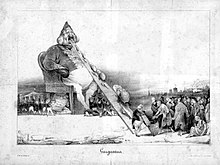志文版 Honoré Daumier (French, 1808–1879) 漢清講堂193 法國藝術家杜米埃(Honoré Daumier) 2017-09-18 'The Burden', the drawing under the name 'Chair in the Orchestra Stalls',

1871
Honoré Daumier 這幅說巴黎公社的"遺產",死傷慘重。
193 法國藝術家杜米埃(Honoré Daumier) 2017-09-18 漢清講堂
https://www.youtube.com/watch?v=z3XmdUngEZM&t=3s
HONORE DAUMIER - MAN OF HIS TIME 約8分鐘
https://www.youtube.com/watch?v=p-Q1ONdc5uw
Honoré Daumier 5分鐘
https://www.youtube.com/watch?v=KXb32NqB9sI
写実主義
19世紀フランスではロマン主義の風潮に対抗し、ギュスターヴ・クールベが写実主義を主張した(レアリスム宣言)。
https://www.youtube.com/watch?v=ASgnDEBbH9s
約4分鐘20秒起
世界の名画。19世紀半ば頃にフランスで展開・発展した美術運動。それまでのロマン主義に対し、対象を抽象化、歪曲化、理想化せず客観的に描写することを理念とするが、その改革的な絵画展開は当時の保守層や伝統主義者らと対立した。また労働者など下層階級の人々の生活や日常を世界の現実と捉え、忠実に再現しているのも本主義の特徴である。本名称『写実主義』は、巨匠ギュスターヴ・クーベルが1855年に開催されたパリ万国博覧会の会場の隣で、「レアリスム館」を設置氏自身の個展を開催したことに由来する。
Honoré Daumier (French, 1808–1879) オノレ・ドーミエ
https://ja.wikipedia.org/wiki/%E3%82%AA%E3%83%8E%E3%83%AC%E3%83%BB%E3%83%89%E3%83%BC%E3%83%9F%E3%82%A8
杜米埃從事版畫創作時,正值法國政局波濤洶湧之際,他發表一系列政治諷刺漫畫,旨在諷刺 、批評當時的君王政體,也為他招致牢獄之災。不能畫政治諷刺漫畫之後,杜米埃改畫插畫、幽默的風俗畫,少了政治的辛辣,多了對市井小民真摰的關懷,同樣極受歡迎。
雖然杜米埃是以諷刺漫畫成,他的雕塑和璯畫一般人都不熟悉,但對於杜米埃而言,他真正的夢想是繪畫。
杜米埃一生創作頗豐,本書完整收錄了他各階段的版畫、精采的人物雕塑,以及油畫、素描作品,是一本欲了解杜米埃其人其藝不可不讀的好書。
National Gallery of Art
Happy birthday to Honoré Daumier, born on this day in 1808. Daumier was self-taught as a painter, and his style has many characteristics of the graphic media in which he trained. Daumier is best known for political cartoons and humorous caricatures satirizing contemporary life. His paintings reveal a more serious examination of the human condition.
In "Wandering Saltimbanques," the artist depicts itinerant street musicians and acrobats without ridicule, revealing the poverty and isolation of their offstage lives. What emotions seem to be expressed in this work of art? http://1.usa.gov/1VHB6jQ
Honoré Daumier, "Wandering Saltimbanques," 1847/1850, oil on wood, National Gallery of Art, Washington, Chester Dale Collection, 1963.10.14
The Metropolitan Museum of Art, New York
F
Happy birthday to Honoré Daumier, born on this day in 1808. As a graphic artist and painter, Daumier chronicled the impact of industrialization on modern urban life in mid-nineteenth-century Paris.
eatured Artwork of the Day: Honoré Daumier (French, 1808–1879) | The Third-Class Carriage | ca. 1862–64 http://bit.ly/1Oo56P6
Musée d'Orsay (officiel)
10th February 1879: death of Honoré Daumier, printmaker, caricaturist, painter, and sculptor...
Illustration :
Don Quixote and the dead mule, détail (1867)
Musée d'Orsay. Donation de la baronne Eva Gebhard-Gourgaud, 1965
© RMN-Grand Palais (Musée d'Orsay) / Hervé Lewandowski
http://bit.ly/20KT6R7
IMAGE: Honoré Daumier (French, 1808–1879) | The Laundress | ca. 1863
Happy birthday to Honoré Daumier, born on this day in 1808. The escape that alcohol offered to the poor is typical of the social themes Daumier explored throughout his career.
Featured Artwork of the Day: Honoré Daumier (French, 1808–1879) | The Drinkers | by 1861 http://met.org/1E11KeP
生平[編輯]
作品[編輯]
Wikipedia article "Honoré Daumier".
Honoré Daumier (February 26, 1808 – February 10, 1879), was a French printmaker, caricaturist, painter, sculptor, and one of the most gifted and prolific draftsmen of his time.
Early life
Born in Marseille, Daumier showed in his youth an irresistible inclination towards the artistic profession, which his father vainly tried to check by placing him first with a huissier, and later, with a bookseller. Having mastered the techniques of lithography, Daumier began his artistic career by producing plates for music publishers, and illustrations for advertisements. This was followed by anonymous work for publishers, in which he emulated the style of Charlet and displayed considerable enthusiasm for the Napoleonic legend.Published works
When, during the reign of Louis Philippe, Charles Philipon launched the comic journal, La Caricature, Daumier joined its staff, which included such powerful artists as Devéria, Raffet and Grandville, and started upon his pictorial campaign of satire, targeting the foibles of the bourgeoisie, the corruption of the law and the incompetence of a blundering government. His caricature of the king as Gargantua led to Daumier's imprisonment for six months at Ste Pelagic in 1832. Soon after, the publication of La Caricature was discontinued, but Philipon provided a new field for Daumier's activity when he founded the Le Charivari.Daumier produced his social caricatures for Le Charivari, in which he held bourgeois society up to ridicule in the figure of Robert Macaire, hero of a popular melodrama. In another series, L'histoire ancienne, he took aim at the constraining pseudo-classicism of the art of the period. In 1848 Daumier embarked again on his political campaign, still in the service of Le Charivari, which he left in 1860 and rejoined in 1864.
Paintings
In addition to his prodigious activity in the field of caricature — the list of Daumier's lithographed plates compiled in 1904 numbers no fewer than 3,958 — he also painted. Except for the searching truthfulness of his vision and the powerful directness of his brushwork, it would be difficult to recognize the creator of Robert Macaire, of Les Bas bleus, Les Bohémiens de Paris, and the Masques, in the paintings of Christ and His Apostles (Rijksmuseum in Amsterdam), or in his Good Samaritan, Don Quixote and Sancho Panza, Christ Mocked, or even in the sketches in the Ionides Collection at South Kensington. As the paintings were never intended for public consumption, Daumier felt free to work in a vein that was personal rather than political. In their more munificent spirit the paintings are close to those of his friends Corot and Millet, though altogether more vigorous in handling.As a painter, Daumier, one of the pioneers of naturalism, did not meet with success until a year before his death in 1878, when M. Durand-Ruel collected his works for exhibition at his galleries and demonstrated the range of the talent of the man who has been called the "Michelangelo of caricature". At the time of the exhibition, Daumier was blind and living in a cottage at Valmondois, which Corot placed at his disposal. It was there that he died.
An exhibition of his works was held at the École des Beaux-Arts in 1900.
Today, Daumier's works are found in many of the world's leading art museums, including the Louvre, the Metropolitan Museum of Art and the Rijksmuseum. He is celebrated for a range of works, including a large number of paintings (29) and drawings (49) depicting the life of Don Quijote, a theme that fascinated him for the last part of his life.
Baudelaire noted of him: l'un des hommes les plus importants, je ne dirai pas seulement de la caricature, mais encore de l'art moderne. (One of the most important men, I will not say only of caricature, but further of modern art.)




No comments:
Post a Comment